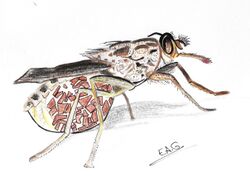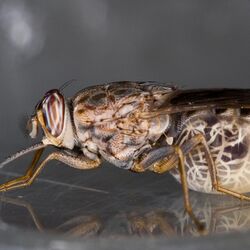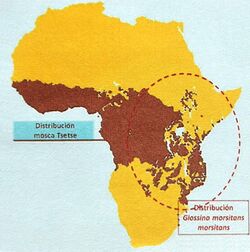Biology:Glossina morsitans
| Glossina morsitans | |
|---|---|

| |
| by es:User:Estefanía Alonso Gómez | |

| |
| Scientific classification | |
| Domain: | Eukaryota |
| Kingdom: | Animalia |
| Phylum: | Arthropoda |
| Class: | Insecta |
| Order: | Diptera |
| Family: | Glossinidae |
| Genus: | Glossina |
| Species: | G. morsitans
|
| Binomial name | |
| Glossina morsitans Westwood, 1851
| |
Glossina morsitans is a species of tsetse fly in the genus Glossina. It is one of the major vectors of Trypanosoma brucei rhodesiense[1] in African savannas.[2]
Taxonomy
Glossina morsitans is variously classified into the subgenus Glossina[2] or as the name species of a morsitans species group. Note that this includes both subspecies G. m. centralis and G. m. morsitans, and G. pallidipes.[2][3]
G. m. submorsitans is a common substitute for G. m. morsitans,[4][3] or rarely as a full species G. submorsitans.
G.m.s. is further subdivided into a G. m. s. ugandensis.[5]
Morphology
Egg
About 1.5–1.6 millimetres (15⁄256–1⁄16 in) long.[6][7]
Larvae
First instar
1.8 millimetres (5⁄64 in) long.[6]
Second instar
4.5 millimetres (11⁄64 in) long.[6]
Third instar
6–7 millimetres (15⁄64–9⁄32 in) long.[6]
Adult
Adults are 7.75 millimetres (5⁄16 in). G. morsitans is occasionally distinguishable from congeners by the unaided eye - there are differences in gross coloration - if it can be observed resting. It is more readily distinguishable by microscopic examination.[8]
Metabolism
Flight muscles are primarily powered by proline, which is synthesized from fatty acids mobilised out of the fat body. Proline is so efficiently used in muscle mitochondria because they are specialised towards proline oxidising enzymes, and away from enzymes using fatty acids and pyruvate.[9]
Distribution
G. morsitans is found heavily throughout East Africa and Equatorial Africa: Angola,[10][3] Benin,[3] Botswana,[10][3] Burkina Faso,[10][3] Burundi,[10][3] Cameroon,[10][3] Central African Republic,[3] Chad,[10][3] Democratic Republic of the Congo,[10][3] Ethiopia,[10][3] The Gambia,[10][3] Ghana,[3] Guinea,[3] Guinea-Bissau,[3] Ivory Coast,[10][3] Kenya,[10][3] Malawi,[10][3] Mali,[10][3] Mozambique,[10][3] Namibia,[10][3] Niger,[10][3] Nigeria,[10][3] Rwanda,[3] Senegal,[10][3] Sierra Leone,[3] South Africa ,[10] Sudan,[10][3] Tanzania,[10][3] Togo,[10][3] Uganda,[10][3] Zambia,[10][3] and Zimbabwe.[10][3]
Hosts
G. morsitans feeds upon warthogs, oxen, buffaloes, kudus, and humans.[1] About 6% of G. m. s.'s bloodmeals come from birds (excluding ostriches).[3]
Genome
A sequence was made available in 2014. Among other results this reveals that G. morsitans's genome has incorporated some of its Wolbachia symbiont's genome (see also § Symbionts below).[11] The sense of taste of G. m. m. lacks the sense of sweetness - which may be due to its exclusively hematophagous diet.[12]
Genetics
G. morsitans carries 3 Ago2s according to data compiled by Mongelli & Saleh 2016[13][14] and Dowling et al 2016 finds 2 Ago3s[14] while Mongelli & Saleh's compilation shows 3.[13][14]
Symbionts
G. m. m. is in obligate symbiosis with Wigglesworthia glossinidia and Wolbachia. Without Wigglesworthia, G. m. m. is sterile, and without Wolbachia they are reproductively incompatible with normal flies.[15]
Economic impact
Trypanosomiasis transmitted by G. morsitans and other tsetse species is one of the largest economic problems Africa faces. It has radically altered the cattle agroeconomy across the middle of Africa, severely shrinking the cattle pastoral lifestyle by shrinking the extent of safe grazing lands. This has left about 10,400,000 square kilometres (4,000,000 sq mi) of otherwise usable land devoid of cattle. Raising cattle in the manner common in 1963, this would have allowed for another 125,000,000 head - more than doubling the 114,000,000 being raised at the time.[16]
References
- ↑ 1.0 1.1 "Tsetse biology, systematics and distribution, techniques". http://www.fao.org/3/p5178e/P5178E07.htm.
- ↑ 2.0 2.1 2.2 Rozendaal, Jan A. (1996). "2. Tsetse flies". Vector Control : Methods for Use by Individuals and Communities. Albany: World Health Organization. pp. 178–192. ISBN 92-4-154494-5. OCLC 927460540.
- ↑ 3.00 3.01 3.02 3.03 3.04 3.05 3.06 3.07 3.08 3.09 3.10 3.11 3.12 3.13 3.14 3.15 3.16 3.17 3.18 3.19 3.20 3.21 3.22 3.23 3.24 3.25 3.26 3.27 3.28 3.29 3.30 3.31 3.32 3.33 "Tsetse biology, systematics and distribution, techniques". http://www.fao.org/3/p5178e/P5178E06.htm.
- ↑ Gooding, R.H.; Krafsur, Elliot Scoville (2005). "Tsetse Genetics: Contributions to Biology, Systematics, and Control of Tsetse Flies". Annual Review of Entomology (Annual Reviews) 50 (1): 101–123. doi:10.1146/annurev.ento.50.071803.130443. ISSN 0066-4170. PMID 15355235.
- ↑ Krafsur, Elliot Scoville (2009). "Tsetse flies: Genetics, evolution, and role as vectors". Infection, Genetics and Evolution (Elsevier) 9 (1): 124–141. doi:10.1016/j.meegid.2008.09.010. ISSN 1567-1348. PMID 18992846.
- ↑ 6.0 6.1 6.2 6.3 "Tsetse biology, systematics and distribution, techniques". http://www.fao.org/3/p5178e/P5178E04.htm.
- ↑ "Tsetse biology, systematics and distribution, techniques". http://www.fao.org/3/p5178e/P5178E03.htm.
- ↑ "Tsetse biology, systematics and distribution, techniques". http://www.fao.org/3/p5178e/P5178E10.htm.
- ↑ Arrese, Estela L.; Soulages, Jose L. (2010). "Insect Fat Body: Energy, Metabolism, and Regulation". Annual Review of Entomology (Annual Reviews) 55 (1): 207–225. doi:10.1146/annurev-ento-112408-085356. ISSN 0066-4170. PMID 19725772.
- ↑ 10.00 10.01 10.02 10.03 10.04 10.05 10.06 10.07 10.08 10.09 10.10 10.11 10.12 10.13 10.14 10.15 10.16 10.17 10.18 10.19 10.20 10.21 10.22 10.23 10.24 "Glossina morsitans morsitans". CABI (Centre for Agriculture and Bioscience International. 2019-11-21. http://www.cabi.org/isc/datasheet/81481.
- ↑ Attardo, G. M.; Abila, P. P.; Auma, J. E.; Baumann, A. A.; Benoit, J. B.; Brelsfoard, C. L.; Ribeiro, J. M. C.; Cotton, J. A. et al. (2014-04-24). "Genome Sequence of the Tsetse Fly (Glossina morsitans): Vector of African Trypanosomiasis (NIHMSID: NIHMS591386)". Science (American Association for the Advancement of Science (AAAS)) 344 (6182): 380–386. doi:10.1126/science.1249656. ISSN 0036-8075. PMID 24763584.
- ↑ Obiero, George F. O.; Mireji, Paul O.; Nyanjom, Steven R. G.; Christoffels, Alan; Robertson, Hugh M.; Masiga, Daniel K. (2014-04-24). Ribeiro, José M. C.. ed. "Odorant and Gustatory Receptors in the Tsetse Fly Glossina morsitans morsitans". PLOS Neglected Tropical Diseases (Public Library of Science (PLoS)) 8 (4): e2663. doi:10.1371/journal.pntd.0002663. ISSN 1935-2735. PMID 24763191.
- ↑ 13.0 13.1 Mongelli, Vanesa; Saleh, Maria-Carla (2016-09-29). "Bugs Are Not to Be Silenced: Small RNA Pathways and Antiviral Responses in Insects". Annual Review of Virology (Annual Reviews) 3 (1): 573–589. doi:10.1146/annurev-virology-110615-042447. ISSN 2327-056X. PMID 27741406. https://hal-pasteur.archives-ouvertes.fr/pasteur-01957180/file/Mongelli%20and%20Saleh.pdf.
- ↑ 14.0 14.1 14.2 Zhu, Kun Yan; Palli, Subba Reddy (2020-01-07). "Mechanisms, Applications, and Challenges of Insect RNA Interference". Annual Review of Entomology (Annual Reviews) 65 (1): 293–311. doi:10.1146/annurev-ento-011019-025224. ISSN 0066-4170. PMID 31610134.
- ↑ Alam, Uzma; Medlock, Jan; Brelsfoard, Corey; Pais, Roshan; Lohs, Claudia; Balmand, Séverine; Carnogursky, Jozef; Heddi, Abdelaziz et al. (2011-12-08). Schneider, David S.. ed. "Wolbachia Symbiont Infections Induce Strong Cytoplasmic Incompatibility in the Tsetse Fly Glossina morsitans". PLOS Pathogens (Public Library of Science (PLoS)) 7 (12): e1002415. doi:10.1371/journal.ppat.1002415. ISSN 1553-7374. PMID 22174680.
- ↑ Wilson, S. G.; Morris, K. R.; Lewis, I. J.; Krog, E. (1963). "The effects of trypanosomiasis on rural economy with special reference to the Sudan, Bechuanaland and West Africa". Bulletin of the World Health Organization (World Health Organization) 28 (5–6): 595–613. ISSN 0042-9686. PMID 14001093.
Further reading
- Lehane, M J; Aksoy, S; Gibson, W; Kerhornou, A; Berriman, M; Hamilton, J; Soares, M B; Bonaldo, M F et al. (2003). "Adult midgut expressed sequence tags from the tsetse fly Glossina morsitans morsitans and expression analysis of putative immune response genes". Genome Biology (Springer Science and Business Media LLC) 4 (10): R63. doi:10.1186/gb-2003-4-10-r63. ISSN 1465-6906. PMID 14519198.
External links
- "Taxonomy browser (Glossina morsitans)". NCBI (National Center for Biotechnology Information). http://www.ncbi.nlm.nih.gov/Taxonomy/Browser/wwwtax.cgi?id=7394.
- [Organism "txid7394[Organism - Nucleotide - NCBI"]. NCBI (National Center for Biotechnology Information). http://www.ncbi.nlm.nih.gov/nucleotide?term=txid7394[Organism.
- [Organism "txid7394[Organism - Protein - NCBI"]. NCBI (National Center for Biotechnology Information). http://www.ncbi.nlm.nih.gov/protein?term=txid7394[Organism.
Wikidata ☰ Q14601424 entry
es:Glossina morsitans morsitans
 |



